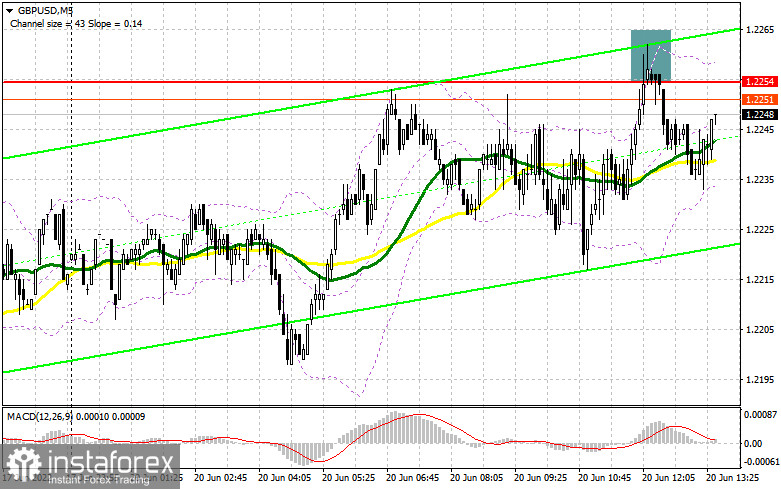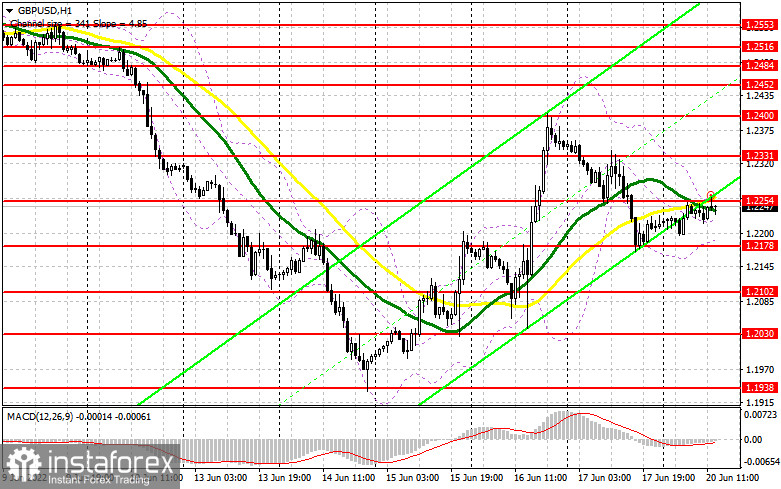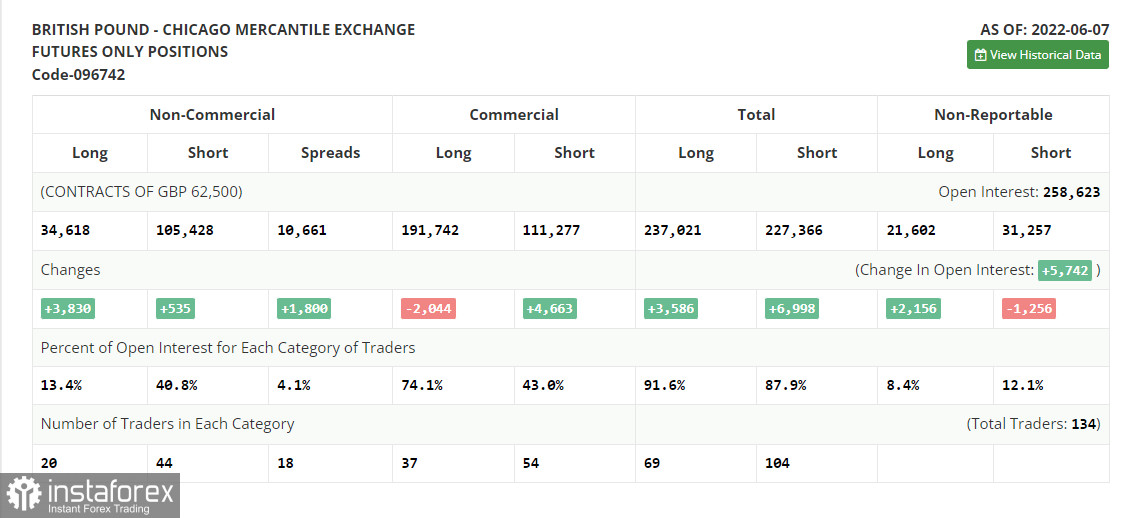In my morning forecast, I paid attention to the 1.2245 level and recommended making decisions from it. Let's look at the 5-minute chart and figure out what happened there. An unsuccessful attempt to return above 1.2254 led to the formation of a false breakdown, which in turn gave signals to sell the pound. However, all the bears managed was a 20–point drop in GBP/USD. We did not reach the key target in the area of 1.2178, after which the demand for the pound returned. Until the moment when trading is conducted below 1.2178, we can expect a further decline in the pair. For the second half of the day, the technical picture remained unchanged, as well as the strategy itself. And what were the entry points for the euro?

To open long positions on GBP/USD, you need:
In the second half of the day, there is no data on the US, and, most likely, volatility will remain at a fairly restrained level, which is likely to play on the side of buyers of the pound, who will continue their attempts to get above 1.2254. The speech of FOMC member James Bullard may coincide with what Federal Reserve Chairman Jerome Powell said last Friday. In his opinion, the Fed will do everything possible to return inflation to the target level of 2 percent in the shortest possible time. If Bullard's interview is similar, the bears may try to return pressure on the British pound, which will lead to the implementation of the morning sell signal. In the event of a decline in the pound in the afternoon, the bulls will have to try very hard to offer something in the area of 1.2178, where the lower boundary of the new ascending channel passes. Therefore, only the formation of a false breakdown at 1.2178 there will give a signal to open new long positions in the expectation of growth to the nearest resistance of 1.2254. This level is critically important for bulls, which is obvious since bears are trying their best not to let the pair go higher. A breakout and a top-down test of 1.2254 will give a buy signal based on the update of 1.2331, and then last week's maximum in the area of 1.2400. A similar breakthrough at this level will lead to another entry point into long positions with the prospect of reaching 1.2452, where I recommend fixing the profits. A more distant target will be the 1.2484 area. If GBP/USD falls and there are no buyers at 1.2178, the pressure on the pair will increase. Then I advise you to open new long positions only on a false breakdown from 1.2102. You can buy GBP/USD immediately for a rebound from 1.2030, or even lower – around 1.1938 with the aim of correction of 30-35 points within a day.
To open short positions on GBP/USD, you need:
The bears coped with the task and defended 1.2254. Now they need to return the level of 1.2178 formed by the results of last Friday as soon as possible. Only a consolidation below 1.2178 and a reverse test from the bottom up will give an entry point into short positions with the prospect of a decline to 1.2102, which will lead to the complete surrender of the pound buyers. A more distant target will be the 1.2030 area, where I recommend fixing the profits. With the GBP/USD growth option, the bears will probably show themselves again already in the area of the nearest resistance of 1.2254, which they should not miss in any way – this will lead to the loss of initiative and the development of an already bullish scenario. Another false breakout at this level will give a good entry point into short positions in the expectation of a resumption of the downward trend. If there is no activity at 1.2254, another upward jerk may occur against the background of the demolition of stop orders of speculative sellers. In this case, I advise you to postpone short positions until 1.2331. But even there, I advise selling the pound only in case of a false breakdown, since going beyond this range will increase demand for GBP/USD. Short positions can be viewed immediately for a rebound from 1.2400, or even higher – from 1.2452, counting on the pair's rebound down by 30-35 points inside the day.

The COT report (Commitment of Traders) for June 7 recorded a large increase in long positions and only a small increase in short ones. However, as I think you understand, at the moment, the picture is completely different: the last three trading days have turned the market upside down. The further direction of the pair, which is in the area of annual lows, depends on the meeting of the Federal Reserve System and the decisions taken at it. A more aggressive policy will push GBP/USD further down, as the UK economy, as the latest data showed, is gradually reducing the growth rate, which does not give confidence to investors. The meetings of the Bank of England are unlikely to help the pound in any way since the regulator will not abandon the policy of raising rates. I very much doubt its further aggressive actions aimed at combating inflation by sacrificing the growth rate of the economy. Although the governor of the Bank of England, Andrew Bailey, continues to say that the regulator is not going to give up on raising interest rates yet, however, there are also no hints of a more aggressive approach to monetary policy. The COT report indicates that long non-commercial positions increased by 3,830, to the level of 34,618, while short non-commercial positions increased by 535, to the level of 105,428. This led to a decrease in the negative value of the non-commercial net position from the level of -74,105 to the level of -70,810. The weekly closing price rose from 1.2481 to 1.2511.

- Moving average (moving average determines the current trend by smoothing out volatility and noise). Period 50. The graph is marked in yellow.
- Moving average (moving average determines the current trend by smoothing out volatility and noise). Period 30. The graph is marked in green.
- MACD indicator (Moving Average Convergence / Divergence - moving average convergence/divergence) Fast EMA period 12. Slow EMA period 26. SMA period 9
- Bollinger Bands (Bollinger Bands). Period 20
- Non-profit speculative traders, such as individual traders, hedge funds, and large institutions use the futures market for speculative purposes and to meet certain requirements.
- Long non-commercial positions represent the total long open position of non-commercial traders.
- Short non-commercial positions represent the total short open position of non-commercial traders.
- Total non-commercial net position is the difference between the short and long positions of non-commercial traders.
 English
English 
 Русский
Русский Bahasa Indonesia
Bahasa Indonesia Bahasa Malay
Bahasa Malay ไทย
ไทย Español
Español Deutsch
Deutsch Български
Български Français
Français Tiếng Việt
Tiếng Việt 中文
中文 বাংলা
বাংলা हिन्दी
हिन्दी Čeština
Čeština Українська
Українська Română
Română

